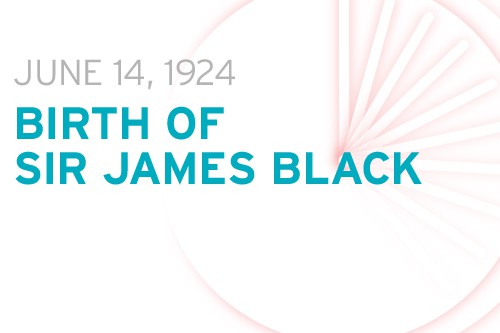
To be involved in the development of just one revolutionary drug that changed the face of medicine would be enough for most researchers. But many millions of people can attribute a better quality of life to the Scottish scientist Sir James Black, the man behind both the beta-blocker propranolol, which revolutionised treatment in hypertension, and cimetidine, which achieved similar success in the treatment and prevention of stomach ulcers.
The now commonly-used drugs were major breakthroughs in their respective fields and both became the biggest-selling medicine in the world for a period; propranolol was sold under the brand name Inderal by British company ICI Pharmaceuticals and cimetidine was sold by Smith Kline & French (now GSK) as Tagamet.
Sir James’ beginnings were rather less auspicious than the life-changing and company-making legacy he left behind. Born in Lanarkshire on June 14 in 1924 – sometime before the modern age of pharmaceuticals had really begun – he was the fourth of five brothers in a coal-mining family.
By his own admission in his speech upon winning the Nobel Prize in Physiology or Medicine in 1988, he “coasted, daydreaming” through most of his school years.
When he did put his mind to his work though he said he was dedicated, first to music between the age of 12 and 14 and then to mathematics from 14 to 16. During this latter period Sir James’ gift for science showed through, however, and he was persuaded by his school maths teacher to sit a scholarship exam for St Andrew’s University.
He passed the test and – under the influence of an elder brother – he chose to study medicine at the prestigious university, graduating in 1946. This was also the same year he married Hilary Vaughan, a fellow St Andrew’s University student who he had met at a ball two years earlier.
The debts acquired through studying and his marriage meant Sir James ended up in Singapore in 1947 to take a teaching position, before moving to London in 1950 once he had made enough money to cover his costs. Back in the UK a chance encounter with his old colleague Prof R C Garry led to hearing of a new opportunity at the Glasgow Veterinary School, where he was offered the chance to create a physiology department.
During this time in Glasgow he worked with George Smith to research ways of increasing the supply of oxygen to the heart in people with narrowed coronary arteries. By 1956 he had formulated a way to develop cell receptor modulators to achieve this aim, taking his idea to ICI Pharmaceuticals.
The company was impressed by Sir James’ research and took him to Alderley Park in Cheshire, where he worked under John Stephenson – a man, Sir James said, who taught him how to ask questions about molecules and converted him to pharmacology.
At ICI he continued to develop his idea to improve oxygen supply to the heart – a goal that had the potential to help people with conditions such as angina and high blood pressure. The breakthrough came in 1964 with the development of propranolol, the first of a new class of medicines called beta-blockers.
Its discovery was subsequently hailed as the greatest breakthrough in the treatment of heart disease since the discovery of digitalis in the 18th century. Propranolol has since benefited millions of people around the world who have had a heart attack, angina, high blood pressure, migraine or even stage fright, although its use is now more limited as new treatments have come out. Nevertheless, it made hundreds of millions for ICI at the time, and is now sold by many companies in a generic form.
Sir James was not one to rest on his laurels though, and he immediately turned his attention to the acid secretions in the stomach that led to stomach ulcers. With ICI uninterested in the idea, he resigned and joined the US group Smith Kline & French – one of several precursors to GlaxoSmithKline (GSK).
His second breakthrough came in the early 1970s with the development of cimetidine – a drug modelled on his beta-blocker research. As with propranolol it was the first drug of its class, acting as an antagonist of the H2 receptor, which plays a vital role in the secretion of stomach acid.
Marketed as Tagamet, the drug made billions of dollars for Smith Kline & French at its peak, outselling propranolol to become the world’s biggest selling prescription medicine.
After these two successes, Sir James decided to move back from commercial research to academia, becoming a professor in pharmacology at University College London. It was a short-lived appointment, however, and “withdrawal symptoms from lack of a chemical collaboration” led Sir James to join the Wellcome Foundation. Despite his previous success, he described this role as the “most productive in my life”, remaining for some years before taking on the role of chancellor of Dundee University.
This final position was one of many honours bestowed upon Sir James in a long career, including an appointment to the Order of Merit, a Nobel Prize and – of course – his knighthood. For many though, his most lasting legacy following his death in 2010 must be not one, but two major breakthroughs in medicine, each of which has improved the lives of millions.





